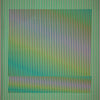Carlos Eduardo Cruz-Diez was born in Caracas, Venezuela, on August 17, 1923. From a young age, he showed an interest in art and studied at the School of Fine Arts in Caracas. He later worked as a graphic and advertising designer in Venezuela. In 1955...
Leer más
Carlos Eduardo Cruz-Diez was born in Caracas, Venezuela, on August 17, 1923. From a young age, he showed an interest in art and studied at the School of Fine Arts in Caracas. He later worked as a graphic and advertising designer in Venezuela. In 1955, Cruz-Diez moved to Europe to further his artistic training, settling first in Madrid and then in Paris, where he would reside until his death. There, he began to experiment with color, making it the central element of his work. In the 1960s, Cruz-Diez joined the kinetic art movement, which is characterized by the use of optical and mechanical elements to create visual effects in artwork. Cruz-Diez developed his own technique, based on the use of chromatic structures, and created a series of works that he called "physichromies". Throughout his career, Cruz-Diez received numerous awards and participated in important international exhibitions, such as the Venice Biennale, Documenta in Kassel, and the "Les Magiciens de la Terre" exhibition at the Centre Pompidou in Paris. His work can be found in important contemporary art collections around the world, including the Museum of Modern Art in New York, the Reina Sofía Museum in Madrid, the Museo de Bellas Artes in Caracas, and the Museum of Modern Art in São Paulo. Carlos Cruz-Diez passed away in Paris on July 27, 2019, but his artistic legacy lives on today, as he is recognized as one of the most important artists of kinetic art and contemporary art in general.
Leer menos


